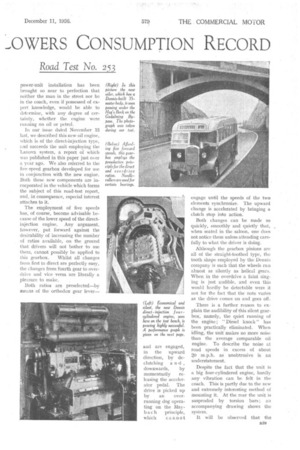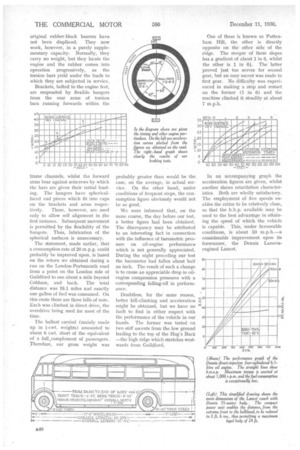LATEST DENNIS LANCET OILER OWERS CO \SUMPTJOY RECORD
Page 56

Page 57

Page 58

Page 59

If you've noticed an error in this article please click here to report it so we can fix it.
Over 19 Miles Covered on One Gallon of Fuel by a Five-speed 35-seater. New Direct-injection Engine Almost as Smoothrunning and Silent as a Similar Petrol Unit T0 carry the maximum number of persons at the minimum cost is the natural aim of the average bus or coach operator. He requires large seating capacity in relation to overall dimensions and big mileage per unit of fuel consumed, whilst he wishes to avoid both a heavy repair bill and the loss occasioned by holding the vehicle in dock.
In the new Dennis Lancet he can have all these desirable attributes to a degree which, at the moment, would be difficult to better. The chassis affords 24 ft. of body space— enough for 39 or even 40 seats—the consumption, with normal loading and under average conditions, would probably exceed 20 m.p.g., whilst, although offered at a competitive price, the machine is built to endure, and to run continuously for long periods without attention, beyond routine servicing operations, which; so far as possible, have been simplified to entail little delay.
Furthermore, in respect of vibration, noise, smoke and smell—the points against which oil-engine criticism is commonly levelled—the Lancet provides an answer, for the power-unit installation has been brought so near to perfection that neither the man in the street nor he in the coach, even if possessed of expert knowledge, would be able to determine, with any degree of certainty, whether the engine were running on oil or petrol.
In our issue dated November 13 last, we described this new oil engine, which is of the direct-injection type, end succeeds the unit employing the Lanova system, a report of which was published in this paper just over a year ago. We also referred to the five-speed gearbox developed for use in conjunction with the new engine. Both these new components are incorporated in the vehicle which forms the subject of this road-test report, and, in consequence, especial interest attaches to it.
The employment of five speeds has, of course, become advisable because of the lower speed of the directinjection engine. Any argument, however, put forward against the desirability of increasing the number of ratios available, on the ground that drivers will not bother to use them, cannot possibly be applied to
this gearbox. Whilst all changes front first to direct are perfectly easy, the changes from fourth gear to overdrive and vice versa are literally a pleasure to make.
Both ratios are preselected—by means of the orthodox gear lever—
and are engaged, in the upward direction, by declutching a n , downwards, by momentarily releasing the accelerator pedal. The drive is picked up by an overrunning dog operating on the May b a. c h principle, which cannot
engage until the speeds of the two elements synchronize. The upward change is accelerated by bringing a clutch stop into action.
Both changes can be made so quickly, smoothly and quietly that, _ when seated in the saloon, one clues not notice them unless attending carefully to what the driver is doing.
Although the gearbox pinions are all of the straight-toothed type, the tooth shape employed by the Dennis company is such that the wheels run almost as silently as helical gears. When in the overdrive a faint singing is just audible, and even this would hardly be detectable were it not for the fact that the note varies as the drive comes on and goes off.
There is a further reason to explain the audibility of this silent gearbox, namely, the quiet running of the engine; "Diesel knock" has been practically eliminated. When idling, the unit makes no more noise than the average comparable oil engine. To describe the noise at road speeds in excess of about 40 m.p.h. as unobtrusive is an understatement.
Despite the fact that the unit is a big four-cylindered engine, hardly any vibration can be felt in the coach. This is partly due to the new and extremely interesting method of mounting it. At the rear the unit is suspended by torsion bars ; an accompanying drawing shows the System.
It will be Observed that the
original rubber-block bearers have not been displaced. They now work, however, in a purely supplementary capacity. Normally, they carry no weight, but they locate the engine and the rubber comes into operation progressively, as the torsion bars yield under the loads to which they are subjected in service. Brackets, bolted to the engine feet, are suspended by flexible hangers from the rear arms of torsion bars running forwards within the frame channels, whilst the forward arms bear against setscrews by which the bars are given their initial loading. The hangers have sphericalfaced end pieces which fit into cups on the brackets and arms respec tively. These, however, are. used only to allow self alignment in he first instance. Subsequent movement is permitted by the flexibility of the hangers. Thus, lubrication of the spherical surfaces is unnecessary. The statement, made earlier, that a consumption rate of 20 m.p.g. Could probably be improved upon, is based on the return we obtained during a run on the London-Portsmouth road from a point on the London side of Guildford to one about a mile beyond Cobham, and back. The total distance was 19.1 miles and exactly one gallon of fuel was consumed. On this route there are three hills of note. Each was climbed in direct drive, the overdrive being used for most of the time. The ballast carried (mainly made up in 1-cwt. weights) amounted to about 6 cwt. short of the equivalent of a full.cornplement of passengers. Therefore, our gross weight was probably greater than would be the case, on the average, in actual service. On the other hand, under conditions of frequent stops, the consumption figure obviously would not be so good. We were informed that, on the same course, the day before our test, a better figure had been obtained. The discrepancy may be attributed to an interesting fact in connection with the influence of barometric pressure on oil-engine performance which is not generally appreciated. During the night preceding our test the barometer had fallen about half an inch. The result of such a change is to cause an appreciable drop in oilengine compression pressures with a corresponding falling-off in performance.
Doubtless, for the same reason, better hill-climbing and acceleration might be obtained, but we have no fault to find in either respect with the performance of the vehicle in our hands. The former was tested on two stiff ascents from the low ground leading to the top of the Hog's Back —the high ridge which stretches westwards from Guildford. One of these is known as Puttenham Hill, the other is directly opposite on the other side of the ridge. The steeper of these slopes has a gradient of about 1 in 6, whilst the other is 1 in 61. The "latter proved just too severe for second gear, but an easy ascent was made iii first gear. No difficulty was experienced in making a stop and restart on the former (1 in 6) and the machine climbed it steadily at about 7 m.p.h.
In an an accompanying graph the acceleration figures are given, whilst another shows retardation characteristics. Both are wholly satisfactory. The employment of five speeds enables the ratios to be relatively close, so that the b.h.p available may be used to the best advantage in attaining the speed of which the vehicle is capable. This, under favourable conditions, is about 50 m.p.h.—a considerable improvement upon its forerunner, the Dennis Lanovaengined Lancet.
Testing the brakes with a somewhat heavier gross weight than in the case of the earlier machine, we were not surprised to find that slightly longer stopping distances were required when each system was used separately. Together, however, a marked improvement was revealed.
This is hard to explain. It may be attributable to some peculiarity of the new type of Dewandre-Lockheed unit employed, or merely to the fact that, during our series of tests, the facings bedded down. The important matter, however, is that the brakes are highly efficacious, the foot-brake alone being capable of sending the ballast weights on the floor of the saloon sliding forwards.
Before ending our report of performance; reference must be made to the steering qualities. Whilst the machine holds a straight course, almost automatically, under normal driving conditions, it can be pulled around a sharp bend with less effort than any comparable vehicle we can recall to mind.
After descending our test hill we had to reverse out of an entry on to a narrow road in order to turn the vehicle for the ascent. This demonstrated unmistakably the ease with which the front wheels can be pulled around when only just moving.
This is the result of another improvement. The swivel pins, besides being equipped with roller thrust bearings, now have needle bearings to take radial loadings.
From the point of view of facilitating maintenance or removing the need for it, there is a number of points that well merit inclusion here.
Adjustments of the clutch-withdrawal mechanism can be made with the greatest of ease.
To prevent failures in the fuel lines, flexible connections are incorporated at points liable to fracture. For these synthetic rubber is used, which is impervious to oil. This is an expensive refinement, a tube made of this material only a few inches long costing several shillings.
The grease nipples are grouped in the conventional manner, but each battery is fully protected in a neat aluminium box with a spring lid.,
As a final example of how nothing has been left undone to ensure reliability, every junction in the wiring system of the coach is contained in a die-cast aluminium box, large ter
minals and fittings being used. An additional advantage of this system is that it simplifies the tracing of faults, as any circuit can be isolated.
In addition to testing the new Lancet on the road, we witnessed a bench test of the engine. In our presence two fuel trials were made.
For the first, the unit was run at full load, at 1,000 r.p.m. developing 51 blip. (102.5 lb. per sq. in., b.m.e.p.) and consumed one pint of fuel in 102.8 seconds, which gives a rate of 0.344 pint per b.h.p.-hr.
For the second, at the same crankshaft speed, running at three-quarter load and developing 41.2 b.h.p. (82.5 lb. per sq. in., b.m.e.p.), the consumption rate was 0.336 pint per b.h.p.-hr.
These trials were carried out with an intake manifold and an exhauster in use. The standard engine has fixed injection and the setting was normal. We believe these figures constitute a record.




































































































